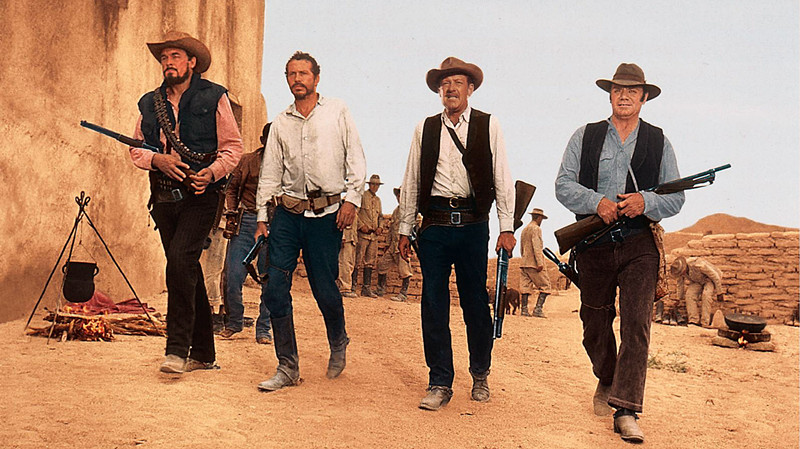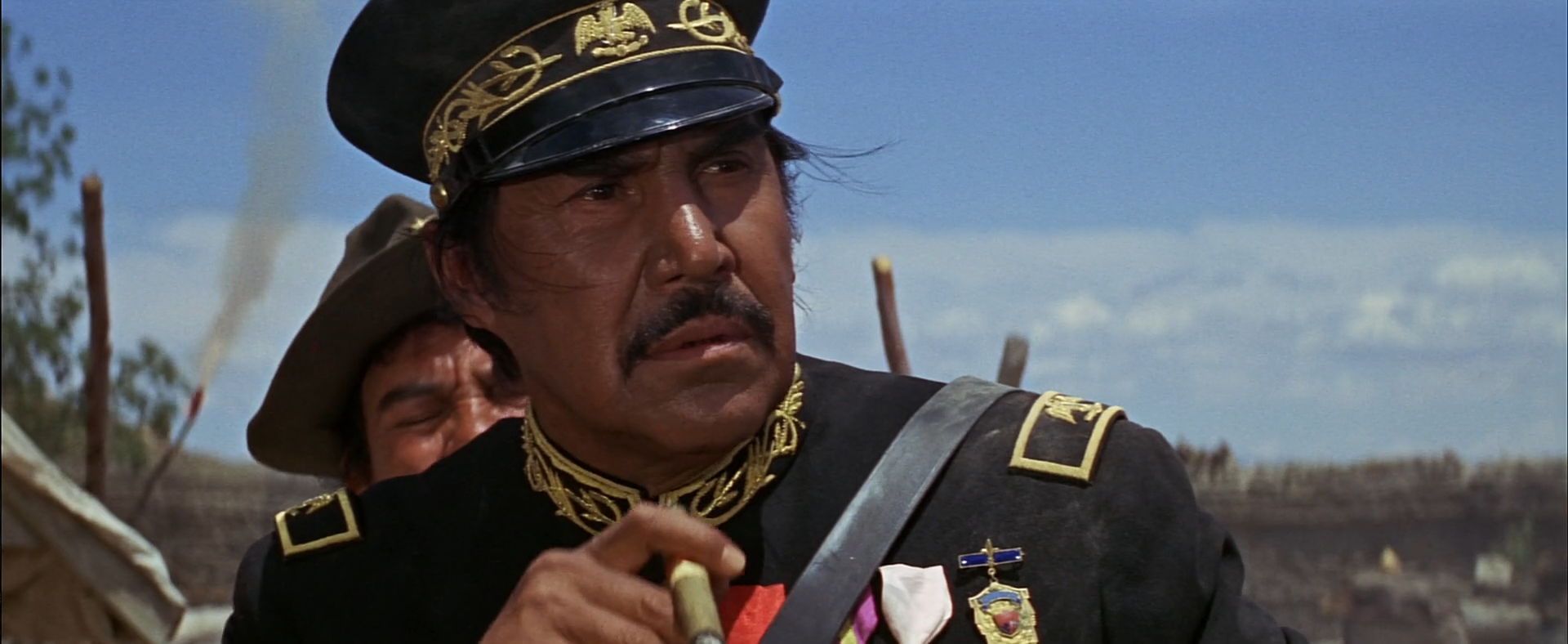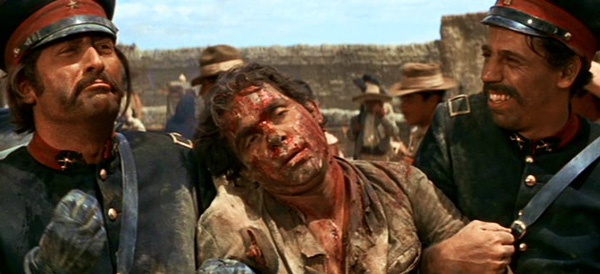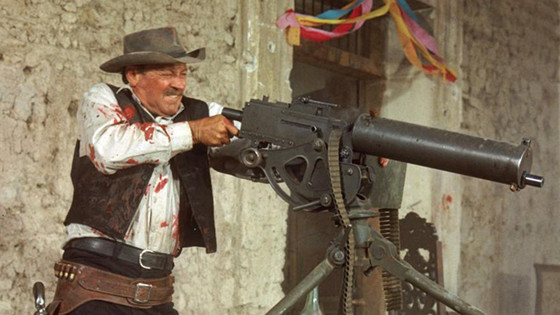
“[The Wild Bunch] is what happens when outlaws go to Mexico.”
– Sam Peckinpah
If they move, kill ’em!
Sam Peckinpah’s breakout picture is an outlaw epic that’s, in purely cinematic terms, a viciously graceful spectacle. With quick, startling cuts, slow motion splatter, multi-angle coverage, inventive sound design, superb cinematography and intricately arranged action scenes, Peckinpah and company utterly revise and rewrite John Ford’s Western mythos –– here it’s the depreciated outlaws and vilified villains who witness the passing of the Old West, and us vicariously through them. It’s a desolately elegiac vision, and an unforgettable one.
From the outset The Wild Bunch bursts with rushing uninterrupted violence: a stylized stormy hellfire of grisly, quick-cut, expressive bloodshed, and almost rhapsodic carnage. It’s an eventful and famous opening scene, combining intense art and brunt influence in ways so innate and forcible that late-1960s audiences reeled, amazed and upset.
“The Wild Bunch is an American masterpiece, one of the greatest ever produced in the Hollywood system… …Few that followed it, even among its many imitators, have its sense of tragedy and loss, its depth, melancholy and lyricism, or its savagery and dark wit.”
– Michael Wilmington
It ain’t like it used to be, but it’ll do

William Holden is aging outlaw Pike Bishop, on the brink of retirement after one last score, knocking over a bank. His gang includes the Gorch brothers, Lyle (Warren Oates), and Tector (Ben Johnson), Angel (Jaime Sánchez), and Dutch Engstrom (Ernest Borgnine), and they all fast learn that the final job they’ve embarked on is a setup strung together by Deke Thornton (Robert Ryan), Pike’s old partner. Fleeing to Mexican territory with Thornton on their heels, the Bunch take refuge and reckoning.
With courage, crooked fatalism, and an unhealthy dram of paranoia, The Wild Bunch is populated with outlaws, soldiers, and lawmen who all reside uncomfortably close to death. Peckinpah, aided by his ace cinematographer Lucien Ballard (The Killing, Ride the High Country), are relentless in their strategy as they dumbfound the viewer right out of the gate, and then, like the Bunch, ready and relentlessly pull you along.
Simultaneously gruesome and strangely romantic, Peckinpah chooses for the first images of the film to be a group of wide-eyed children torturing ants and scorpions as the U.S. Army rides into town. Of course, it’s not the army, it’s the Bunch, gunning for the bank and bloodshed that will follow. Constantly cutting back and forth to the children watching the bloody bank raid, the juxtaposition is unsettling and darkly droll as the kids imitate the adults; their posture, their affectation; and then irrevocably they participate.
The bank job goes south so completely as the Bunch realizes they don’t have bags of payroll but bags of metal washers. Heavy casualties ensue as bandits, bounty hunters, and innocents get shot to shit until, thankfully for the Bunch, a temperance union parade marches straight into their thunder and they’re able to beat a hasty retreat.
“I saw the original version at the world premiere in 1969… …[The Wild Bunch] became one of the most controversial films of its time –– praised and condemned with equal vehemence, like Pulp Fiction. At a press conference the morning after the premiere, Holden and Peckinpah hid behind dark glasses and deep scowls; it was rumored that Holden had been appalled when he saw the film. After a reporter from the Reader’s Digest got up to ask ‘Why was this film ever made?’ I stood up and called it a masterpiece; I felt, then and now, that The Wild Bunch is one of the great defining moments of modern movies.”
– Roger Ebert
Next time, you better plan your massacre more carefully or I’ll start with you!

The despotism and tyranny of pre-Revolutionary Mexico doesn’t sit so well with the Bunch, and with the American frontier essentially vanishing before them they’re out of options and on the run. General Mapache (Emilio Fernández), aided and abetted by German advisors are supposed to be, in theory, on the level legitimate government but they’re evilly corrupt.
“I wrote [The Wild Bunch] thinking that I would like to see a Western that was as mean and ugly and brutal as the times, and the only nobility in men was their dedication to each other.”
– Walon Green (screenwriter)
We’ve got to start thinking beyond our guns

Before our grizzled and leaden heroes take the classic “last stand” compromise Peckinpah attunes and tightens his decision to drag the cowboy movie parable into the present-day. My showing us the Model T Ford we see mass-production on the horizon and by giving us the Gatling gun we glimpse mass-produced murder and carnage, too. The old and antiquated Western cliché that conflicts amongst men can have a tidy resolution is kicked to the curb.
The Bunch and the Mexican army they thrash it out with are fighting a furious, filthy, and heartless war. Women and children are not spared the lash, either. Peckinpah has no qualms showing the viewer what destruction and wreckage bullets are capable of as bodies are tossed, torn, and burst, and blood jets and savagely spews.
This was the late 1960s after all, and televisions were showing uncensored images of the Vietnam conflict into people’s living rooms like never before. The public was suddenly and shatteringly made aware of civilian populations suffering as innocent lives got lost in the preventable hostilities.
The realism and revision that The Wild Bunch displayed in blood-spattered spades effectively reclaimed the Western back from the Italians. Peckinpah could certainly hemorrhage more plasma than Sergio Leone or Sergio Corbucci combined while providing a doleful and defiled lyricism absent from many horse operas, too.
“What Citizen Kane was to movie lovers in 1941, The Wild Bunch was to cineastes in 1969.”
– Michael Sragow, The Baltimore Sun
They’ll be waiting for us
The Wild Bunch reaches a finish much like its savage inception; a bloody and unforgiving impasse. An entire Mexican army detachment square off against the surviving members of the Bunch, now whittled down to four souls, and a Gatling gun locked in a very literal Mexican standoff. Thrown in the mix are some mercenaries, too, making for a maniacal menage a trois of nightmare magnitude, crazed nihilism, and for our antiheroes, a shocking grace.
“The bloody deaths are voluptuous, frightening, beautiful,” wrote Pauline Kael. “And it’s no accident that you feel a sense of loss for each killer of the Bunch: Peckinpah has made them seem heroically, mythically alive on the screen.”
Author Bio: Shane Scott-Travis is a film critic, screenwriter, comic book author/illustrator and cineaste. Currently residing in Vancouver, Canada, Shane can often be found at the cinema, the dog park, or off in a corner someplace, paraphrasing Groucho Marx. Follow Shane on Twitter @ShaneScottravis.